Related Research Articles
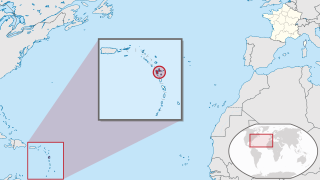
Guadeloupe is an archipelago and overseas department and region of France in the West Indies or Caribbean. It consists of six inhabited islands—Basse-Terre, Grande-Terre, Marie-Galante, La Désirade, and the two inhabited Îles des Saintes—as well as many uninhabited islands and outcroppings. It is south of Antigua and Barbuda and Montserrat and north of the Commonwealth of Dominica. The region's capital city is Basse-Terre, located on the southern west coast of Basse-Terre Island; however, the most populous city is Les Abymes and the main centre of business is neighbouring Pointe-à-Pitre, both located on Grande-Terre Island. It had a population of 378,561 in 2024.
This is a list of the demographics of Martinique, a Caribbean island and an overseas department/region and single territorial collectivity of France.
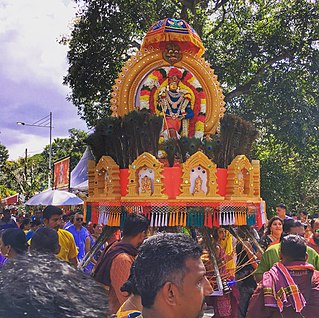
Thaipusam or Thaipoosam is a Tamil Hindu festival celebrated on the first full moon day of the Tamil month of Thai coinciding with Pusam star. The festival is celebrated to commemorate the victory of Hindu god Murugan over the demon Surapadman using a vel, a divine spear granted by his mother, Parvati.
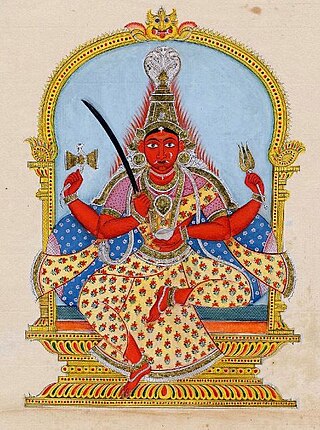
Mariamman, often abbreviated to Amman, is a Hindu goddess of weather, predominantly venerated in the rural areas of South India. Her festivals are held during the late summer/early autumn season of Ādi throughout Tamil Nadu and the Deccan region, the largest being the Ādi Thiruviḻa. Her worship mainly focuses on bringing rains and curing diseases like cholera, smallpox, and chicken pox. Mariamman is worshipped in accordance with local traditions such as Pidari or the Gramadevatai. She is considered as a guardian deity by many South Indian village-dwellers.

Hinduism in Thailand is a minority religion followed by 84,400 (0.1%) of the population as of 2020. Despite being a Buddhist-majority nation, Thailand has a very strong Hindu influence. The majority of Thai Hindus reside in Bangkok, Chonburi, and Phuket.

Hinduism is the leading single religion of the Indo-Caribbean communities of the West Indies. Hindus are particularly well represented in Guyana, Suriname and Trinidad and Tobago. The Cayman Islands also hosts a sizable Hindu population, with 2.4 percent of the country affiliating with the religion. Smaller groups of Indo-Caribbeans live elsewhere in the Caribbean, especially Puerto Rico, Jamaica, Belize, Barbados, Saint Vincent and the Grenadines, Saint Lucia, and Bahamas.

Hinduism is a minority religion in France that is followed by more than 121,312 people in France, which is nearly 0.2% of the nation's population. Most of the Hindus in France are mainly from Indian diaspora, though there are many Hindus from Nepal, Afghanistan, Mauritius and other nations.

Arulmigu Sri Mariamman Temple, Samayapuram is an ancient Hindu temple in Tiruchirappalli district in Tamil Nadu, India. The main deity, Samayapurathal or Mariamman, a form of Adi Parashakti, is made of sand and clay with extractions of medicinal herbs unlike many of the traditional stone idols and is considered as most powerful Goddess, and hence unlike many other Hindu deities there are no abhishekams conducted to the main deity, but instead the "abishekam" is done to the small stone statue in front of it.

The village deities of Southern India are the numerous spirits and other beings venerated as part of the Dravidian folk tradition in villages throughout South India. These deities, mainly goddesses, are intimately associated with the well-being of the village, and can have either benevolent or violent tendencies. These deities are presently in various stages of syncretism or assimilation with mainstream Hindu traditions.

Karuppu Svami is a Tamil god in Tamil Nadu, popular among the rural social groups of Tamil Nadu and Kerala. He is one of 21 guardian deities of Ayyanar, and is one of 21 guardian deities in Dravidian folk religion.

Tamil mythology refers to the folklore and traditions that are a part of the wider Tamil pantheon, originating from the Tamil people. This body of mythology is a fusion of elements from Tamil culture and the parent Indus Valley culture, both of which have been syncretised with mainstream Hinduism.

Indo-Guadeloupeans are mostly descended from indentured workers who came mostly from South India in the late 19th century. There are currently about 35,617 people of Indian origin living in Guadeloupe, making it home to one of the largest South Indian populations in the Caribbean.
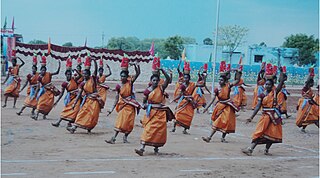
Karakattam, or Karagam Puja in the Caribbean, is an ancient folk dance of Tamil Nadu performed in praise of the rain goddess Mariamman. The ancient Tamil epic says that this type of dance derived from Bharatham and a mixture of multiple forms of Tamil dance forms like Bharatanatyam postures and mudras. The offering of this dance is to the goddess to bless rain. The dance accompanies songs like folk Carnatic (Amrithavarshini).

Sri Maha Mariamman Temple, also known as Maha Uma Devi Temple (Thai: วัดพระศรีมหาอุมาเทวี; RTGS: Wat Phra Si Maha Umathewi and Wat Khaek in Thai, is a South Indian architecture style Hindu temple on Si Lom Road in Bangkok, Thailand. It was built in 1879 by Vaithi Padayatchi, a Tamil Hindu immigrant.
Indo-Martiniquais are an ethnic group of Martinique, compromising over 10% of the population of the island. The Indo-Martiniquais are descendants of indentured labourers of the nineteenth century from India of primarily Tamil and Telugu descent as well as other Indian peoples. They are primarily most concentrated in the northern communes of Martinique, where the main plantations were located. The Indo-Martiniquais speak Martinique Creole, a French-based creole that most residents of Martinique speak along with French.
Hinduism in Tamil Nadu finds its earliest literary mention in the Sangam literature dated to the 5th century BCE. The total number of Tamil Hindus as per 2011 Indian census is 63,188,168 which forms 87.58% of the total population of Tamil Nadu. Hinduism is the largest religion in Tamil Nadu.
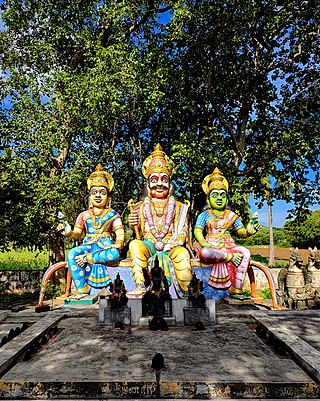
The early Dravidian religion constituted a non-Vedic form of Hinduism in that they were either historically or are at present Āgamic. The Agamas are non-Vedic in origin, and have been dated either as post-Vedic texts, or as pre-Vedic compositions. The Agamas are a collection of Tamil and Sanskrit scriptures chiefly constituting the methods of temple construction and creation of murti, worship means of deities, philosophical doctrines, meditative practices, attainment of sixfold desires and four kinds of yoga. The worship of tutelary deities and sacred flora and fauna in Hinduism is also recognized as a survival of the pre-Vedic Dravidian religion. Dravidian linguistic influence on early Vedic religion is evident; many of these features are already present in the oldest known Indo-Aryan language, the language of the Rigveda, which also includes over a dozen words borrowed from Dravidian. The linguistic evidence for Dravidian impact grows increasingly strong as one moves from the Samhitas down through the later Vedic works and into the classical post-Vedic literature. This represents an early religious and cultural fusion or synthesis between ancient Dravidians and Indo-Aryans that went on to influence Indian civilisation.
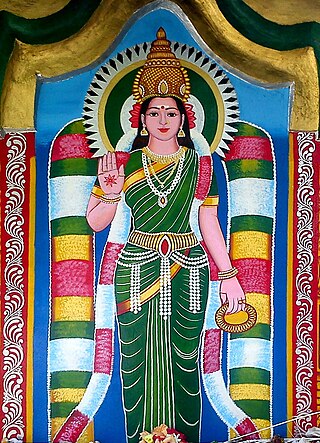
Kannaki Amman is the deified form of Kannagi, the heroine of the Tamil epic Cilappatikāram. She is primarily worshipped in Sri Lanka and Kerala, and in a minor way in few parts of Tamil Nadu. As a goddess of chastity, she is venerated by Indian Tamils and Malayalis, Sri Lankan Tamil Shaivites, and also by the Sinhalese Buddhists as Pattini Amma. In regional Hindu tradition, her tale is interpreted as the story of Durga demanding justice after the death of her husband, Kovalan, who is identified as a form of Shiva.

Hinduism is a minority religion in Guadeloupe, followed by some Indo-Guadeloupeans. According to a statistics data, Hinduism is practised by 0.5% of the people in Guadeloupe.
Caribbean Shaktism, also known as Kalimai or Madras Religion in Guyana, refers to the syncretic Shakti Kali/Mariamman worship that has evolved within the Indo-Caribbean Tamil community in countries such as Trinidad and Tobago, Guyana, Guadeloupe, Martinique, Jamaica and Suriname. It can be found across the Caribbean and any South American country with an Indo-Caribbean community. It is a syncretic blend of Dravidian folk religion and Hinduism and has also been influenced by other cultural and religious traditions found in the Caribbean such as Catholicism, Trinidad Orisha, Comfa and Obeah. It is considered to be a form of Folk Tamil Hinduism and many attend services of Vedic Origin, more Orthodox Tamil Origin, and Madrasi origin.
References
- ↑ "Couples – Family – Households in 2020 − Population census - Results for all municipalities, departments, regions, intermunicipal authorities ... | Insee". www.insee.fr. Retrieved 2024-03-10.
- ↑ "Tamil (Christian traditions) in Martinique".
- ↑ "Culture of Martinique - history, people, women, beliefs, food, customs, family, social, dress".
- ↑ http://www.worldmap.org/uploads/9/3/4/4/9344303/martinique_profile.pdf [ bare URL PDF ]
- ↑ Taylor, Patrick; Case, Frederick I. (2013-04-30). The Encyclopedia of Caribbean Religions: Volume 1: A - L; Volume 2: M - Z. University of Illinois Press. ISBN 9780252094330.
- ↑ Taylor, Patrick; Case, Frederick I. (2013-04-30). The Encyclopedia of Caribbean Religions: Volume 1: A - L; Volume 2: M - Z. University of Illinois Press. ISBN 9780252094330.
- ↑ "Martinique".
- ↑ "Basse-Pointe Review - Martinique Caribbean - Sights | Fodor's Travel".
- ↑ "Culture of Martinique - history, people, women, beliefs, food, customs, family, social, dress".